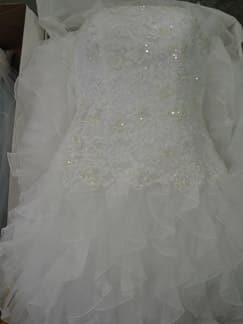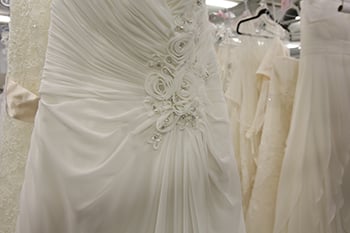 Most brides want to preserve their dress as a keepsake, perhaps for their own daughter to wear on another special day. Executive Cleaners recommends that your dress should be expertly cleaned before storage.The dress may have invisible stains from food, beverages, and body oils. These will later appear as permanent yellow stains if not properly cleaned. On a long gown, the hemline may be soiled.Point out any stains or spills to us. We will expertly remove the stains and clean and freshen the entire gown. Most wedding gowns contain decorative trim of some type. Often these trims are not constructed to withstand a dry-cleaning process.
Most brides want to preserve their dress as a keepsake, perhaps for their own daughter to wear on another special day. Executive Cleaners recommends that your dress should be expertly cleaned before storage.The dress may have invisible stains from food, beverages, and body oils. These will later appear as permanent yellow stains if not properly cleaned. On a long gown, the hemline may be soiled.Point out any stains or spills to us. We will expertly remove the stains and clean and freshen the entire gown. Most wedding gowns contain decorative trim of some type. Often these trims are not constructed to withstand a dry-cleaning process.
 Beads and glitter may be attached to the gown with adhesive which becomes soluble in dry-cleaning. This can result in the complex loss of beads or similar tri. Some beads my look like pearls but are made of plastic such as polystyrene. Polystyrene dissolves or softens in most drycleaning solvents, causing a loss or tackiness of the beads. Beads and glitter can also be covered with coatings not resistant to solvent. After cleaning, shiny or brightly colored beads and glitter may be dull or colorless.
Beads and glitter may be attached to the gown with adhesive which becomes soluble in dry-cleaning. This can result in the complex loss of beads or similar tri. Some beads my look like pearls but are made of plastic such as polystyrene. Polystyrene dissolves or softens in most drycleaning solvents, causing a loss or tackiness of the beads. Beads and glitter can also be covered with coatings not resistant to solvent. After cleaning, shiny or brightly colored beads and glitter may be dull or colorless.
Sequins may be applied either by sewing or gluing. Some glues used are not solvent resistant, resulting in loss in cleaning. Sequins may also contain a colored surface coating which may dissolve in cleaning. Some may soften and curl with the necessary heat of deodorizing after dry-cleaning or during finishing. Sequins applied with a chain stitch can unravel if the stitch breaks.
Lace and embroidered trim may be adhered with solvent-soluable glues. In such cases, mu
ch of the trim may be totally separated from the gown in cleaning. The Care Label Rule clearly states that wearing apparel, such as a wedding gown, must have a care label giving a viable care method. The care label covers all component parts of the gown, including all decorative trim. Gowns which fail to withstand the care procedure on the label should be returned to the retailer for an adjustment.
Storing Your Gown

Executive Cleaners will pack the gown for you in a special storage box. This is a convenient way to store the gown and offers some protection from dust and contaminants in the air. Unfortunately, no process or storage method yet known can guarantee against eventual yellowing or possible deterioration of textile fibers. When you take your gown home, store it in a cool, dry place. Do not store it in a basement or attic. Attic heat could promote yellowing of the fabric. The dampness of a basement could cause growth of mildew.

If you are storing a long gown on a hanger, it is a good idea to sew straps to the waistline of the dress to relieve pressure on the shoulders from the weight of the skirt. These straps should be a little shorter than the bodice. Wrap the dress in a protective white sheet or muslin covering. Whether the gown is being hung or stored boxed, the bodice should be stuffed with white tissue paper to prevent wrinkles. Fabric covered metal buttons, pins and sponge padding should be removed and stored separately. Metal trims could oxidize and stain the fabric. Some padding materials can deteriorate and yellow with age and stain the fabric. Keep in mind that headpieces and veils are often very fragile. They may deteriorate even in the best of storage conditions.
 In some cases, decorative trim , may yellow because the oxidation of the finishes used. In other cases, an ivory or ecru trim may lose its color and no longer match the gown. This may happen of a dye component is lost in cleaning. Color failures of this type are due to poor colorfastness of the dye selected in dyeing, not to improper drycleaning.
In some cases, decorative trim , may yellow because the oxidation of the finishes used. In other cases, an ivory or ecru trim may lose its color and no longer match the gown. This may happen of a dye component is lost in cleaning. Color failures of this type are due to poor colorfastness of the dye selected in dyeing, not to improper drycleaning.
Most fabrics naturally tend to yellow with age. Often this type of yellowing can be overcome if the gown can be carefully wetcleaned. If your heirloom gown has discolored, or if your own becomes yellow with age, trust your gown to Executive Cleaners. We understand the restoration of delicate and antique materials.

 Our approach to conducting business is different - we continually raise the bar of quality in the dry cleaning community. Recognized by the International Fabricare Institute for a true commitment to high dry cleaning quality, Executive Cleaners achieved a performance level that few dry cleaning companies achieve. The results were deemed "absolutely superb" by professionals in the industry. Frankly, we would accept nothing less.
Our approach to conducting business is different - we continually raise the bar of quality in the dry cleaning community. Recognized by the International Fabricare Institute for a true commitment to high dry cleaning quality, Executive Cleaners achieved a performance level that few dry cleaning companies achieve. The results were deemed "absolutely superb" by professionals in the industry. Frankly, we would accept nothing less.